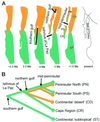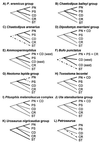Cryptic vicariance in the historical assembly of a Baja California peninsular desert biota
- PMID: 11095731
- PMCID: PMC18937
- DOI: 10.1073/pnas.250413397
Cryptic vicariance in the historical assembly of a Baja California peninsular desert biota
Abstract
We use analyses of phylogeographic population structure across a suite of 12 mammalian, avian, amphibian, and reptilian species and species-groups to assess the role of Late Miocene to Pleistocene geological history in the evolution of a distinct Baja California Peninsular Desert biota. Comparative examination of phylogroup distributions provides support for previously hypothesized vicariant events produced by: a middle Pleistocene midpeninsular seaway, a late Pliocene northward transgression of the Sea of Cortéz, and a Pliocene seaway across the southern peninsular Isthmus of La Paz. Most of this phylogeographic architecture is cryptically embedded within widespread taxonomic species and species-groups, such that the unique evolutionary history of the Peninsular Desert has been obscured and ignored. The Peninsular Desert can no longer be considered a subset of the Sonoran Desert-it is a separate regional desert with its own unique evolutionary history, ecological arena, and conservation value.
Figures




Comment in
-
Evolutionary biogeography on Mexico's Baja California peninsula: A synthesis of molecules and historical geology.Proc Natl Acad Sci U S A. 2000 Dec 19;97(26):14017-8. doi: 10.1073/pnas.260509697. Proc Natl Acad Sci U S A. 2000. PMID: 11114205 Free PMC article. Review. No abstract available.
References
-
- Good D A. Herp Monogr. 1994;8:180–202.
-
- Brown J H. Macroecology. Chicago: Univ. of Chicago Press; 1995.
-
- Riddle B R, Hafner D J. Global Ecology and Biogeography. 1999;8:433–441.
-
- Planz J V. Ph.D. dissertation. Denton: Univ. of North Texas; 1992.
-
- Zink R M, Blackwell R C, Rojas-Soto O. Condor. 1997;99:132–138.
Publication types
MeSH terms
Substances
Associated data
- Actions
- Actions
- Actions
- Actions
- Actions
- Actions
- Actions
- Actions
- Actions
- Actions
- Actions
- Actions
- Actions
- Actions
- Actions
- Actions
- Actions
- Actions
- Actions
- Actions
- Actions
- Actions
- Actions
- Actions
- Actions
- Actions
- Actions
- Actions
- Actions
- Actions
LinkOut - more resources
Full Text Sources

